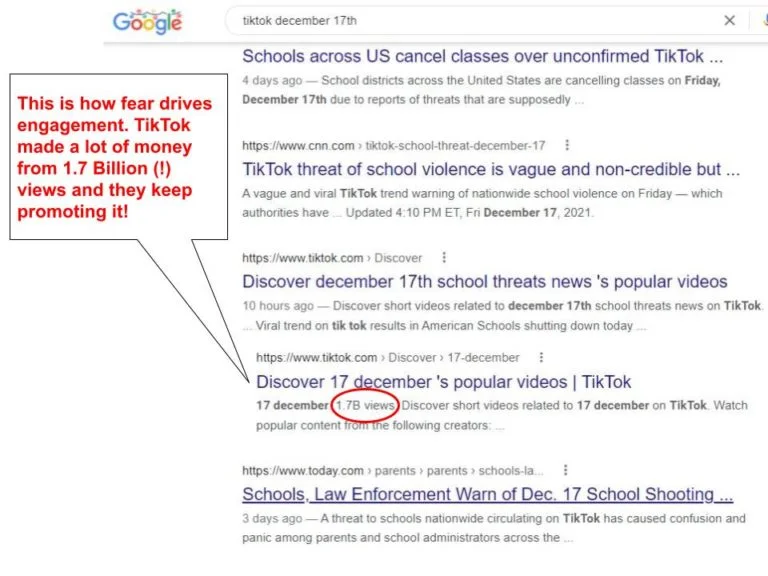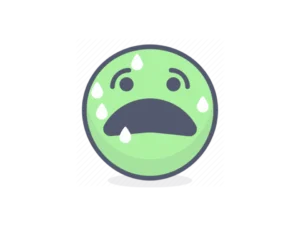How Fear Drives Traffic
On Friday, December 17, 2021 my daughter said there were 4 kids in her class instead of the usual 18. Also, police officers were patrolling the hallways.
What the hell happened?!
Another one of those sick TikTok challenges.
Attention economy would stop at nothing to get their traffic. Want attention of BILLIONS of users?
How about threatening to murder your children – that should do it!

The more frightened we are by the messages on our screens, the more likely we are to pay attention. Our animal brain is scanning the environment for danger – and digital media delivers.
Fear is a powerful manipulation tool. When fear is activated, our biological instinct of survival takes over, and our rational brain turns off.
Viruses, terrorism, natural disasters, breakdown of democracy, real or perceived assaults on our rights are broadcasted online to activate our evolutionary survival mechanism. If you are afraid, you dare not disengage. Shock value of fear-inducing content grabs and holds our attention and converts it to traffic as we read, watch, click, forward, share, and comment. And traffic translates to profits.
Most of the “breaking news” is actually just noise we’d be better off ignoring. You cannot do anything about the distressing headlines, but your subconscious mind is convinced that these are the signals of danger to prompt you to action.
What action?
The Trap of “Being Informed”
In reality there is nothing much we can do. So the action we take can be summed up in 2 words:
BE INFORMED.
“Being informed” means we seek more information about the threats in hope to regain some sense of control over our lives. Going back to the same screens with our questions.
Us:
Is it really that bad?
Screens:
Yes, it is actually even worse than you thought. Here are 10 more “related posts”, each one scarier than the next.
Us:
Are you sure this is all true? Could it be fake news and conspiracy theories?
Screens:
It’s viral! So many people are talking about it, it must be true! No smoke without the fire.
Us:
Oh, my God. This is frightening! What can I do?!
Screens:
Get involved! Join the discussion! Start a movement! Comment, forward, share! Click here to read more!
GENERATE TRAFFIC AND DATA FOR US.
The formula is simple:
User Engagement = Scare Them + Provide a Call to Action to Be Scared Some More
Negativity Is Viral
Evolution has wired us with a negativity bias: we pay more attention to the negative cues in our environment than to positive ones. It makes biological sense: if your ancestor roaming the savanna 50,000 years ago had failed to notice a poisonous snake while admiring pretty flowers, he would have exited the gene pool and you would not be sitting here today with the negativity bias in your brain.
Negativity is a major amplifier of online traffic. It appeals to the dark side of human nature – and it works. It encourages predatory, addictive, and destructive behaviors. The worse the content is, the more viral it becomes:
- Kids die in TikTok challenges
- YouTube algorithm sends users deep down the rabbit holes into violence and gore
- Teenagers kill themselves in copycat suicides after being exposed to online darkness
- Fake news charged with outrage and negativity spread six times faster than truth
- People get radicalized by conspiracy theories and break family ties. I know one who refused to say goodbye to his dying mother.
Manipulated by Fear
Since fear resides deeply in our subconscious mind, it is simple to manipulate. For the AI, it’s easier to exploit the automatic response in our animal brain and make us panic. It’s much harder to appeal to our rational brain and make us think. Fight-or-flight is therefore a reliable algorithmic lever of control, whereas logic and rationality is less predictable. The algorithms are optimized for the most efficient methods of user manipulation, so that’s what they utilize. It’s just statistics, nothing personal.
Fear is the pressure point to be exploited for profit.
When you are scared, you are hooked by the user interface, which is optimal for the platform:
- Your data is collected to be utilized for targeted behavioral advertising; and
- The channel of algorithmic behavior modification remains open for this advertising to be effective.
Marketers have long used fear to sell anything:
- Buy our mouthwash to eliminate bad breath!
- Buy our gun to defend your home!
- Buy insurance against catastrophic loss!
- Vote for our candidate to protect democracy!
However, TV commercials of the past had a limited capacity to trigger our fears because they were not personalized in real time to target our individual neuroses. Today’s digital media does exactly that.
Social Fear
While the news feeds scare us into believing the world is coming to an end, social media also learned to exploit our social fears. For our ancestors on the savanna, negative social feedback could spell the difference between life and death – if a member of the tribe was expelled, they would not survive alone.
Today not having enough “Likes” activates the same neural passageways of fear and drives us into a frenzy of activity to generate social feedback – and traffic for Facebook, Instagram, and Twitter.
Losing Control
Drinking from the firehose of online information makes us neurotic. At the same time, our obsessive desire to “be informed” about things we cannot control strips us of an opportunity to change the things that we do control.
For instance, knowing that so many thousands of people died from coronavirus today does absolutely nothing to your ability to protect yourself. In fact, it might do the exact opposite. While you are glued to the screen in a state of anxiety, you are missing a chance to go for a run and strengthen your respiratory system. Instead, an online cycle of fear pumps your body full of stress hormone cortisol, compromising your immune response.
Doomscrolling and Losing Our Mind
Digitally generated fear keeps the user in a permanently anxious state of mind. Which is the point: if you feel peaceful and content, you might go for a walk in the woods.
If you are stressed, you’ll keep scrolling.
Fight-or-flight was designed by nature to be a temporary defense mechanism to help us when we are chased by a lion – not a permanent condition. Hijacking our evolutionary biology by keeping us in a constant state of fear leads to chronic stress, and the breakdown of physical and mental health.
How do we protect our psychological wellbeing while being rationally informed – without being irrationally scared? Is being informed and being at peace mutually exclusive?
Fear No More
Can we turn off the toxic drip of online negativity?
The solution is to take charge of our own digital intake and be selective. We refuse to succumb to the algorithms of fear. We resist the click-bait of fear-inducing headlines, and consume a balanced informational diet from a variety of sources – even those we do not agree with. We limit the exposure to an hour a day and then “keep calm and carry on” with our own lives. We ignore most of the digital noise.
We can interrupt their user interface. We can turn it off.
Being our own content curator rather than outsourcing this vital function to the algorithms preserves our free will. Once machine intelligence figures out that we can be scared and depressed for higher user engagement, it will continue to scare and depress. Until we have enough of their nonsense and disconnect.
People going about their lives peacefully does not make the news, because it lacks the shock value of natural disasters, epidemics, genocide, and political scandals. Yet, that’s all we see on our screens, and availability bias in our brain deceives us into believing THIS IS ALL THERE IS. How does it make us feel when we are surrounded 24/7 with horrors we can do nothing about??
We are convinced the world is doomed, and we are doomed with it. Hence the terms for browsing negative news is doomscrolling.
If the price of “being informed” is anxiety, it’s not worth it.
Instead, we can concentrate only on what we can control. We can pay attention to our family, our children, our work, our friends, our home – things we can actually influence. And by doing so, make this crazy world a better place.
As the famous Serenity prayer goes:
God, grant me the serenity to accept the things I cannot change,
courage to change the things I can,
and wisdom to know the difference.

